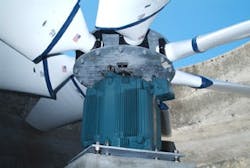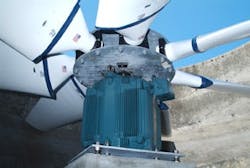Cooling Tower Fans Driven by Less
The story of Baldor's new adjustable-speed, direct-drive cooling tower motor and drive system began in the Fort Worth, Texas, home of cooling tower manufacturer Tower Engineering Inc. TEI is a 27-year-old manufacturer of long-term performance, high-efficiency, field-erected water cooling towers. Company president Rod Applegate's lifelong dream was to develop a "one moving part" mechanical drive system for use in water cooling towers. After many years of work, Applegate learned of Baldor Electric Company's similar work with permanent magnet rotor (PMR) technology for heavy industry applications.
In 2008, the technologies of permanent magnet rotors, finned laminated frames and specialized drives converged to produce the high power density at low rpm needed to fit the system into the available space. The two companies used their extensive experience with demanding applications in harsh environments to bring them together to develop this application.
The collaborative effort resulted in a drive system designed specifically for the rigors of water cooling tower use. This technology replaces traditional NEMA-design motor, speed reducer and drive shaft assemblies with one moving part for the benefits of green operation, improved safety, increased reliability and the highest operating efficiency available today.
Baldor's proof-of-concept PMR motor produces 50 hp at 208 rpm. Installed in mid-2008, it drives an 18-ft.-diameter fan in one of two identical cooling tower cells at Clemson University in South Carolina. It replaced a two-speed, 326T-frame motor producing 50/12.5 hp at 1765/885 rpm, which drove the fan at a ratio of 8.5:1 through a size 155 gearbox.
Clemson undertook the role of test bed with some trepidation. Originally built in 1986, the twin cells had given the university's facility managers little trouble, but they were unsure how much maintenance effort the fans had received. Concerns about losing maintenance personnel and their expertise, along with the promise of improved efficiency, led Clemson to take on the tests.
Measurements before the retrofit indicated the same current draw—47 A—on both cells at full speed. After the retrofit, at full power the new drive system drew 11.8% fewer kW than the unmodified cell. At an average price of $0.08/kWh, Baldor calculates annual energy cost savings of $900 to $3,200, depending on the duty cycle and proportion of high and low speeds. The new system also is quieter (74.4 dBA versus 82.3 dBA) and exhibits less vibration.
Test details were presented at the 2009 Cooling Technology Institute Annual Conference in February. The paper can be found at www.baldor.com/CoolingTower.
Reliability concerns in the fan application center around the axial and radial loads exerted by the large fan blade and exposure of the vertical-shaft motor to the cooling tower's wet environment, so after 3,300 operating hours, the prototype was pulled, disassembled and inspected. Reliability engineers found no evidence of water ingress or bearing degradation.
Baldor's RPM AC synchronous permanent-magnet motor uses laminated, finned-frame construction. The stator laminations themselves comprise the stator housing, which maximizes the amount of efficiency-producing lamination steel, minimizes weight and bulk, and provides a direct heat conduction path for motor cooling. For this application, it is constructed as a totally enclosed air-over motor with a slinger and an Inpro bearing isolator to keep water out, and is equipped with foot mountings designed for drop-in replacement of common cooling-tower right-angle gearboxes.
The motor is paired with the company's VS1CTD PM cooling tower drive preprogrammed with the critical motor operational parameters to simplify installation and startup. When the fan is off, the drive provides a trickle current to warm the motor and prevent internal condensation.
The drive system is now available in sizes from 9.5 hp through 118 hp, 150 rpm to 500 rpm, to drive cooling tower fans from 7 ft. to 18 ft. diameter.
For more information, visit www.baldor.com/CoolingTower.


